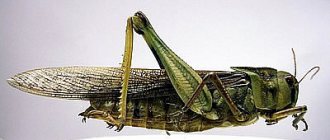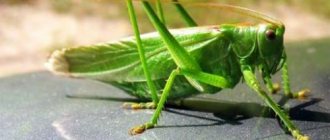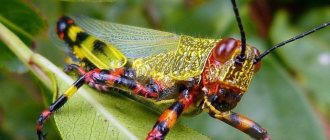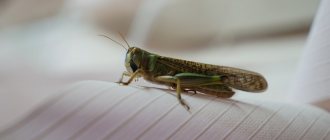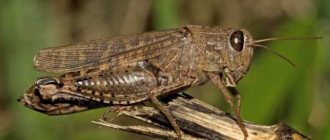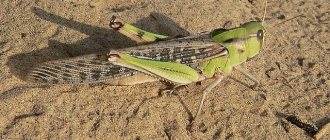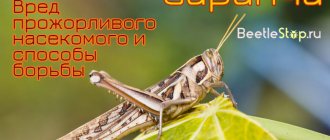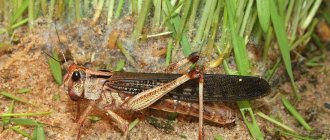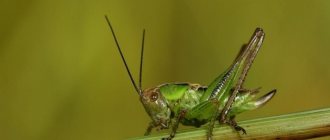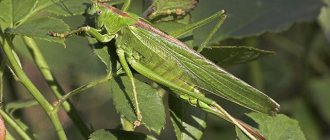The locust insect lives everywhere, with the exception of the Far North and Antarctica. You can meet him in a forest clearing, in a city park, in a ditch by the side of the road, in a vegetable garden. In its own way, this is a unique creature in which two development programs are genetically embedded. While the locust lives as a hermit, unaware of its own kind, it is completely harmless. But as soon as she sees her closest relatives, the spirit of collectivism awakens in her. Insects unite in numerous swarms and cause devastating damage to farmers.
General characteristics of the pest
Locust sizes vary from 3 to 7 cm. Females are larger than males. The body is oblong, attached to it are rigid elytra and a pair of translucent wings, which remain invisible when folded. The color is very variable and depends on the age, conditions and lifestyle that the locust leads:
- Even individuals emerging from the same oviposition may differ in coloring.
- What a locust looks like is also determined by the phase of its development.
- In the European zone, single individuals are predominantly yellow, brick, green, olive, brown in color, which helps to camouflage against the background of the surrounding vegetation.
- The older the individual, the darker its color becomes.
- If the locust joins the swarm, it acquires the same color as the rest of the team members.
The large head is not particularly mobile. Large crescent-shaped eyes and a rectangular, almost square muzzle of the locust give the insect a good-natured appearance. The gnawing mouthparts are represented by powerful jaws that help gnaw through even the thickest and most durable stems. The insect gnaws leaves with its upper mandibles, and only then crushes them using its lower mandibles.
A distinctive feature of locusts from their closest relatives: crickets and grasshoppers is their short whiskers, their length does not exceed half the body.
The pinkish hind legs are well developed, which allows the locust to jump at a distance of 20 times its length. It is no coincidence that insects are endowed with jumping abilities. In the larval stage, they still cannot fly and their motor capabilities are limited to crawling and jumping. Some species do not exhibit flight activity even as adults.
How long locusts live depends on environmental conditions. Rainy seasons provoke the development of fungal plant diseases, which leads to insect infection and death. Natural enemies: wild wasps, beetles, birds can also shorten life expectancy. Humans also make their contribution by destroying pests. If the locust is in optimal conditions and has not become anyone’s victim, then it can live from 8 months to 2 years, depending on the species.
Insect diet
For the most part, locusts spend their time on leaves, flowers, and grass. Locusts are the most vegetarians without any obvious food preferences. Most species do not care what kind of crop it is - wild or agricultural. They feed on the leaves of plants, trees, shrubs, and all ground parts of plantings. Only some species prefer herbaceous plants. During its life, an insect eats an average of 300-350 g of plant mass, and the daily volume is twice its own weight.
For some species, poisonous plants serve as food. As toxic components accumulate in the locust's body, it becomes poisonous. These individuals are characterized by bright, flashy colors, which seem to warn of the danger of everyone who wants to feast on locusts.
When insects gather in swarms, what the locusts feed on depends on the objects that come across its path. In this case, even thatched roofs and reeds, not to mention vegetables, grains, and melons, can be eaten. As eyewitnesses say, during insect attacks, locusts only devour bricks and iron.
The insect is bred as food for various exotic animals. Therefore, the question of what locusts eat at home does not surprise anyone. In insectariums they are fed twice a day with grain, green herbs, and some owners even prepare sprouted wheat for their pets.
Nutrition
The insect cannot be called picky. It can feed on both wild and agricultural crops.
The locust is a vegetarian, and its daily diet can exceed its own body weight by 2 times. A flock can destroy both a field sown by a person and harvested straw.
And during the long flight of the locust, it can even eat its own relative, thereby replenishing the lack of water and nutrients.
How do locusts reproduce?
Females begin laying eggs in late summer, in autumn. To do this, she makes a hole in the soil and lays her eggs in it. A special secretion is released from a special gland, which, like foam, fills all the holes between the eggs and creates a strong, reliable protection. Once hardened, the ovipositor appears in the shape of a long tube called an egg capsule.
One female makes several clutches, after which she dies. In European latitudes, the eggs spend the winter in the ground, and with the arrival of warmer weather, white larvae emerge from them. They are distinguished from their parents by their tiny size and underdeveloped wings. After a few hours, the larva acquires a characteristic color and begins to feed intensively. After 4-6 weeks, having undergone 4 molts, it turns into an adult.
In warm tropical climates, females lay eggs year-round and the number of generations per year can be 6-8.
Reproduction mechanism
During the mating season, the male insect begins to secrete a special substance, a hormone, to attract a female. An interested female approaches her partner, who jumps on her astride, as if riding a filly. After this, his genitals are firmly attached to the female’s organs.
The female genitals have an ovipositor equipped with denticles (subsequently, these denticles, like gimlets, dig the ground to bury the egg). The male inserts a spermatophore (a vesicle containing sperm) into this ovipositor. The entire process of depositing sperm into the ovipositor takes 2-14 hours .
After fertilization, the female looks for moist soil, drills holes in it and lays eggs. First, it secretes gluten with a foamy consistency, then eggs. There are from 50 to 70 pieces in one clutch, and the process lasts almost 2 weeks. The emerging larva has difficulty getting out from under the ground. Now 5 molts must pass before the larva transforms into a full-fledged, sexually mature insect.
If there is an abundance of food all year round, then the locusts will also breed all year round. On average, one female manages to lay 6-12 eggs in her entire life. It must be said that locusts do not belong to the category of caring mothers. For example, female bees or wasps supply each cell with a supply of food so that the larva does not starve at first. The locusts have laid their eggs. considers her mission completed and the future fate of her offspring does not interest her. Her motto: “Everyone survives as best they can.”
Phases of development
As has already been noted, locusts have two development options: solitary and gregarious, which are strikingly different from each other.
Single cycle
The locust filly, as single individuals are called, develops freely with an abundance of food and leads an inactive, shy lifestyle, which is why it was previously systematized as a separate species. Single individuals are characterized by camouflage coloration and pronounced sexual dimorphism. The filly does not cause significant harm.
In fact, a single phase of locust development is necessary for the preservation of the population. The female lays eggs and when the food supply becomes insufficient to feed all the larvae, the locust moves on to another stage of development.
Herd development
Association in swarms is observed in hot, dry years, when locusts begin to experience a shortage of food and moisture. According to recent studies, a lack of protein provokes females to intensively lay so-called “campaign” offspring.
Interesting! In laboratory conditions, many mirrors were placed in the area of a sedentary filly. Seeing her reflections, the female began to actively lay eggs according to the “walking program”.
Gathering into a large tribe, intense friction against each other, the visibility of their own kind, the smell of fellow tribesmen causes a powerful production of serotonin in the nervous system.
Due to the release of the hormone, individuals literally undergo dramatic morphological changes in a matter of hours:
- change of color;
- increase in size;
- leveling sexual dimorphism.
Clusters of adult flying locusts are called swarms; the larvae form swarms. The population moves, as if on command, in one direction. Weakened individuals are eaten along the way by their fellow tribesmen. Adult locusts are capable of long flights and cover from 90 to 140 km per day.
The length of the flocks is measured in tens of kilometers, and the number can reach several billion individuals. The weight of such “collectives” reaches tens of tons.
The locust invasion cannot go unnoticed. The sound of approaching insects is comparable to the sound of thunder, and the flock itself covers the sun.
On its way, the flock devours literally everything, even the thatched roofs of houses, vineyards, orchards, vegetable and grain plantations. Just decades ago, locust attacks caused famine. Now the flocks are causing colossal losses to farmers. In 2015, a locust invasion in Russia destroyed an area comparable to the territory of an entire state, for example, Romania.
Photo
Forms of locust development in pictures:
Single peaceful form
Herd Form
Young Asian locust without wings
Types of locusts
There are many types of locusts. Most of them quickly adapt to new conditions and develop new territories.
The largest locust
This is the largest locust of all migratory species. The size of females reaches 8 cm, males are slightly smaller - 6 cm. Color can vary from dirty yellow to brown. There are many veins on the wings. Lives mainly in the Sahara and Hindustan.
The most intense bright yellow color is found in larvae and males. The mating process of bright individuals is very interesting. The male begins to chirp furiously, attracting the female. The female, who liked the musical accompaniment, kindly allows the male to climb on her back. Mating continues for several hours. Some cavaliers like to mount the female so much that they continue to do this even at the moment when the female is busy laying eggs. Life expectancy is only 8 weeks.
Asian locust
The Asian migratory locust has inconspicuous colors in brownish, greenish, and yellowish tones. The wings are also not characterized by bright colors. The insect can be found throughout Europe, Asia, the south of the Caucasus, Siberia, Korea, and China.
Egyptian locust
This is the largest locust found in Europe. The body length of females can reach 7-8 cm. Only the South American locust can compete with its size. According to some sources, they grow up to 20 cm in length, but there is no exact evidence of this.
The Egyptian locust is distinguished by its gray, olive, greenish, and yellow color. The shins are bright orange. Terrorizes Europe, North Africa.
Countermeasures
To prevent agricultural disasters, the number of insects at different stages of development of migratory locusts is monitored in breeding areas.
Such accounting makes it possible to predict the appearance of the gregarious form and apply insecticides in the phase of population growth, including barrier treatment of nesting sites.
The biological enemies of locusts are insectivorous mammals and birds (especially starlings), as well as some fungi that are pathogenic for orthopterans.
Agrotechnical prevention of the growth of the Asian locust population is:
- Drainage of floodplains of rivers and lakes using them for agricultural plantings.
- Improvement of pastures by mass sowing of forage grasses. The soil, densely entwined with roots, becomes unsuitable for laying eggs.
- Deep plowing of areas infested with locusts, with turning over of the earth layer and harrowing.
- Spring disc loosening along roadsides and slopes of irrigation canals.
Asian migratory locust (family name - locusts), type of development - indirect. During the period of mass reproduction, this pest poses a real threat to all agricultural crops.
The rise in the number of these insects can be prevented by agrotechnical and biological prevention, as well as timely treatment of breeding sites with insecticides.
The benefits and harms of locusts
The greatest damage is caused by swarms of locusts that destroy fields and plantings. However, the average person, who does not care about the safety of the crop, is more interested in the answer to the question of whether locusts bite. The insect eats exclusively plant food and does not bite humans, unlike its fellow grasshopper.
An equally pressing question is whether locusts are eaten. Orthoptera are the most commonly consumed insects after ants. In African countries they fry it and mix it into flat cakes. Arab women several centuries ago could prepare 2 dozen dishes from locusts. Culinary recipes have lost their relevance due to a shortage of ingredients.
In California, during locust outbreaks, entire feasts were held. The captured insects were soaked in a marinade, then crushed and prepared into soups. The Japanese marinate it in soy sauce and fry it. In a word, there are many recipes for cooking locusts, but not everyone can appreciate its taste, not so much because of inaccessibility, but because of disgust.
Fighting methods
Having become acquainted with the voracious locusts and having studied the types of locusts in the photo , we will now consider ways to get rid of them. We already know something about this. And it allows us to conclude that until now humanity has not been lucky enough to come up with 100% methods of combating the invasion of hordes of these insects.
So far there are the following, tested in practice, possibilities.
- Insecticides. They are only effective if there is strict monitoring and control of the situation. The emergence of the gregarious form of locusts must be foreseen in advance. After all, it is recommended to use chemicals only before swarms of insects have time to rise into the air, but exist in the form of clutches and locusts.
You can act later, but not very effectively. Moreover, given the countless number of locusts, it is easy to imagine what harm the implementation of this method in practice can cause to nature and living organisms.
- Agrotechnical prevention consists of deep plowing and harrowing of the land, carried out in the fall after harvesting and in the spring before sowing in the fields, as well as in places where harmful insects potentially accumulate. This helps destroy their clutches. Such measures are urgently needed in those areas of the planet where locust outbreaks periodically occur.
- Biological weapons. Many birds and animals eat locusts with pleasure and in large quantities. By the way, body locust is a very valuable protein. This circumstance plays into people’s hands and is already actively used in some countries. In China, for example, a large number of ducks of a special breed are bred - proven insect killers.
Each of these birds is capable of eating up to two hundred pests per day. An army of ducks has already proven its indispensability in the fight against rampant, voracious creatures about 20 years ago. Chickens also eat locusts, although in much smaller quantities. This environmentally friendly method of control is also much cheaper.
China is raising a special breed of duck to fight locusts
Man himself can become a kind of biological weapon for exterminating evil creatures. After all, these insects not only bring hunger to people, but are also able to turn into nutritious food, especially in regions affected by drought, which still do not have high yields, and therefore the gluttony of insects does not cause much harm. Here the invasion of hellish creatures literally turns into salvation.
Fried locusts are very loved and popular in many Asian countries; they are also used to make soups. Locusts have recently been actively bred for sale, not only for food, but also offered as a delicacy for exotic atypical pets, for example, huge spiders. Feeds of this type are also in demand in poultry farming.
In Asia, people use locusts for food.
Therefore, this business in Europe often turns out to be very profitable, and locust farms are thriving. In our country, for example, frozen locusts in a package of only a hundred pieces can be bought for 2,000 rubles, because the cost of hellish insects is several times higher than the prices of many rare products.
Locusts and grasshoppers: how to distinguish
These two insects are very similar, so not everyone can determine the difference between a grasshopper and a locust. As a result, grasshoppers are exterminated in dachas, mistaking them for pests, but they are useful creatures - they destroy the Colorado potato beetle, aphids and other garden parasites.
Locusts and grasshoppers have several differences:
- The locust's body is long, while the grasshopper's is shorter and wider at the sides;
- The grasshopper's whiskers are longer;
- the grasshopper is active at night, and the locust during the day;
- locusts eat plants, and grasshoppers eat insects;
- The grasshopper's muzzle is oblong, the locust's is rectangular.
